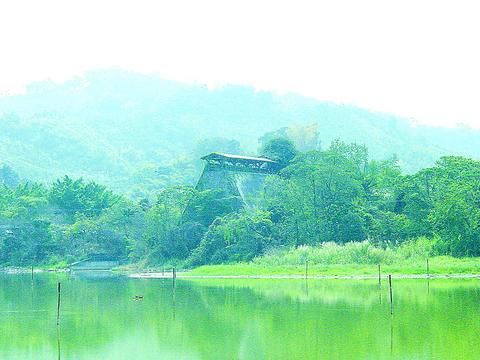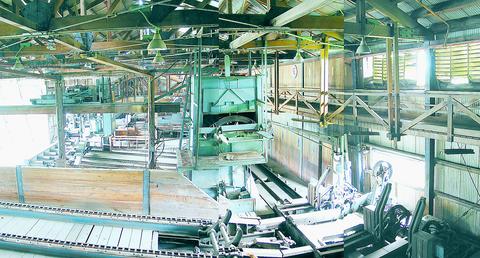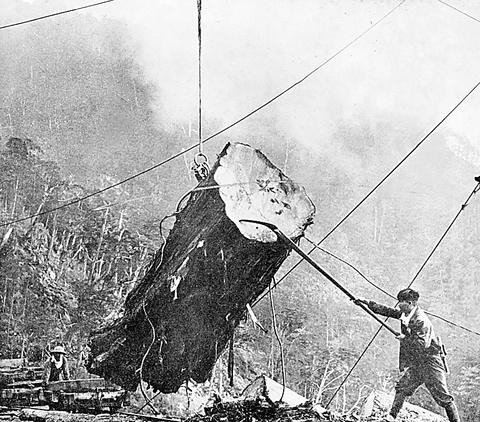In the small township of Tungshih (
Ironically, the move to have the logging station made into a museum had its inspiration in a recent major disaster, namely the 921 Earthquake, which devastated much of central Taiwan. Tungshih was one of the heaviest-hit areas on the island. More than 300 lives were lost, hundreds were injured and numerous houses ruined. Volunteers were brought in to help -- one of these was Yen Ming-hung (
The vast and somewhat dilapidated shelter where he worked covered more than 18 hectares. The buildings used to house the offices and factories of the Tahsue Mountain Forestry Company (大雪山林業公司), which was a major lumber company in the 1960s.

PHOTO COURTESY OF YEN MING-HUNG
The forestry company had come into existence in early 1959, using US government aid and designs by a Seattle, Washington company. At the time, it was state-of-the-art. But after about 10 years, it was forced to close down, a victim of management problems that included embezzlement and lumber theft. Thereafter, it sat idle for 30 years, isolated in the quiet, conservative and yet culturally rich Hakka township.
Changing policies
Shieh Shang-ta (

PHOTO COURTESY OF YEN MING-HUNG
Prior to this, the KMT government had followed the example of the Japanese colonial government in bringing in much-needed foreign exchange with massive exports of cypress and other high-value timber. Taiwan yellow cypress, which holds claim to be the best of the seven types of cypress, now costs approximately NT$70,000 per cubic meter.
One report indicates that the island of Taiwan once possessed around 20,000 hectares of natural cypress forest. Grown over hundreds of years, some of the giant trees are over 1,000 years old. The oldest one on record in Taiwan is now 3,000-years-old and is more than 25m in diameter.
Thirty years of ruthless deforestation begun by the Japanese has reduced the cypress forest area by about half. This quantity continues to diminish despite a total ban on harvesting these trees at high elevations (from 1,800m to 2,500m above sea-level) that was started in 1976.

PHOTO COURTESY OF YEN MING-HUNG
The Tahsue Mountain Forestry Company was designed specifically to continue this exploitation in company-owned lands that extended from Taichung all the way up to Nantou and Hualien counties. The combination of a policy change, coupled with internal mismanagement, made the company a lost cause and led to its demise in 1973, representing a loss of several hundred million NT dollars for investors. Nowadays, 99 percent of the timber Taiwan consumes is imported from Indonesia or other Southeastern Asian countries.
One man's loss may be another man's gain. Because this forestry company folded within a relatively short period of time, Taiwanese forest conservationists had the good luck to have saved most of the cypress trees on the central Taiwan mountains from the sharp blade of US-made bandsaws. The office-and-factory sites were kept almost intact over these long years.
Idle land
The machinery and related facilities inside several of these old factory buildings now serve as an inspiration to the many artists who are involved in a reutilization project.
The plant's high wooden ceilings, sunlight filled rooms, shadowy stairways and the fragrance of cypress emanating from the timber give full rein to the imagination and a sense of long-preserved energy being released from the surroundings.
Lin Ping (
Last year, Lin and others was invited by Yen and Liou Shuenn-ren (劉舜仁), professor of architecture at Tunghai University to set up an evaluation team. They are now presenting ideas to the Forestry Bureau, the sole landowner of the site, in the hope of turning this magnificent site into a forestry art museum.
Professor Liou, who serves as the team's convener, has high hopes for the conversion of the old timber factory. He said: "This is an ideal example of the decay of a raw material enterprise in a post-industrialized economy. Many wineries, sugar plants and railway warehouses in Taiwan were squeezed out of business for more or less the same reason ? industrialization. Obviously, the land these fallen enterprises owned needs to be released for reutilization."
A new plan
The Forestry Bureau had a plan in the past to develop this site into a forest ecology tourism zone, but it was never carried out. Now, Liou says that his team is just trying to carry out the Bureau's plan.
Both Liou and Yen emphasized that this site is perhaps the only large cypress mill left in the world. The factory is built entirely with top-grade wood that forms its beams, columns, frame structures and even floors. What the forestry company left to them is not only an architectural and cultural legacy but also holds unlimited potential for artistic expression.
The concept of reutilization of idle space is still very new in Taiwan. The movement came about in 1997 when three artists in Taipei forced their way into the Huashan Art District (
Yen, Lin and Liou see the possibility of achieving something pleasant and memorable for Taiwan with the Council's support. For example, its funding enabled Liou's team to recently organize a series of public cultural displays on this site to bring more attention to this secluded place.
Meanwhile, the fabulous example set by the Musee D'orsay in Paris, a building converted from an old railway station, is a constant inspiration.
Other internationally renowned projects such as the successful revitalization project of Loire's industrial zone at Feydeau Island in France in 1999, the Salamanca old town conversion plan in Spain, the converted Ruhr Industrial Park in Germany and I. M. Pei's current museum project constructed from the foundations of a medieval Luxemburg castle's walls, are similarly fine examples of reutilization.
The team aims to achieve the same high standard, setting up a world-class forestry ecological museum that makes use of the artwork and expertise of local artists.

The Taipei Times last week reported that the rising share of seniors in the population is reshaping the nation’s housing markets. According to data from the Ministry of the Interior, about 850,000 residences were occupied by elderly people in the first quarter, including 655,000 that housed only one resident. H&B Realty chief researcher Jessica Hsu (徐佳馨), quoted in the article, said that there is rising demand for elderly-friendly housing, including units with elevators, barrier-free layouts and proximity to healthcare services. Hsu and others cited in the article highlighted the changing family residential dynamics, as children no longer live with parents,

The classic warmth of a good old-fashioned izakaya beckons you in, all cozy nooks and dark wood finishes, as tables order a third round and waiters sling tapas-sized bites and assorted — sometimes unidentifiable — skewered meats. But there’s a romantic hush about this Ximending (西門町) hotspot, with cocktails savored, plating elegant and never rushed and daters and diners lit by candlelight and chandelier. Each chair is mismatched and the assorted tables appear to be the fanciest picks from a nearby flea market. A naked sewing mannequin stands in a dimly lit corner, adorned with antique mirrors and draped foliage

The election of Cheng Li-wun (鄭麗文) as chair of the Chinese Nationalist Party (KMT) marked a triumphant return of pride in the “Chinese” in the party name. Cheng wants Taiwanese to be proud to call themselves Chinese again. The unambiguous winner was a return to the KMT ideology that formed in the early 2000s under then chairman Lien Chan (連戰) and president Ma Ying-jeou (馬英九) put into practice as far as he could, until ultimately thwarted by hundreds of thousands of protestors thronging the streets in what became known as the Sunflower movement in 2014. Cheng is an unambiguous Chinese ethnonationalist,

I was 10 when I read an article in the local paper about the Air Guitar World Championships, which take place every year in my home town of Oulu, Finland. My parents had helped out at the very first contest back in 1996 — my mum gave out fliers, my dad sorted the music. Since then, national championships have been held all across the world, with the winners assembling in Oulu every summer. At the time, I asked my parents if I could compete. At first they were hesitant; the event was in a bar, and there would be a lot